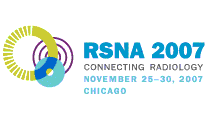
Abstract Archives of the RSNA, 2007
Maged Mofied Ghaly MD, Presenter: Nothing to Disclose
Richard Byrnes, Abstract Co-Author: Nothing to Disclose
To describe a straightforward single phase (IMRT) technique simultaneously deliver high radiation dose to the prostate and lower dose to the pelvic nodes with conventional fractionation.Introduction:IMRT is superior to 3-D CRT in reducing the major limiting toxicities of dose-escalated prostate radiotherapy. IMRT simultaneous integrated boost strategy (SIB) irradiates the prostate via hypofractionation while irradiating pelvic nodes with the conventional fractionation; carries the risk of increased toxicities.A sequential two-phase IMRT planning, initial and boost irradiation, requires two different dosimetric plans and potentially two different treatment setups, which increasing the chance for errors and the cost of patient care.
Out of twenty patients treated for high risk prostate cancer, data of 5 were used as example cases. Radiotherapy was delivered using single phase IMRT, the prostate/seminal vesicle and pelvic lymph nodes planning target volumes (PTVs) were treated simultaneously (i.e., for each fraction, the prostate and pelvic lymph nodes received 1.8 Gy ) to total dose of 79.2 Gy to the prostate/seminal vesicle and 45 Gy to the pelvic nodes . The isocenter of the prostate field was adapted to coincide with the isocenter of the pelvic field, thus creating a mono-isocentric technique. Sequential two-phase IMRT plan, initial pelvic nodes then boost, was retrospectively generated for each patient. Dose-volume histograms for PTVs, bowel, bladder and rectum were compared for the two techniques. Target volumes receiving 90% and 100% of the prescribed dose (V90 and V100) were calculated. Acute toxicities were evaluated weekly during treatment using the Radiation Therapy Oncology Group morbidity Grading Scales.
All plans were generated using commercial inverse planning software (Pinnacle3 versions 6.2b). Target coverage was similar in both techniques. Single isocenter IMRT plan reduced the mean dose to the bowel by 10%. The mean dose to the rectum was also reduced by approximately 20%. Volume of bladder and rectum exposed to high-dose regions (V100, V90) was similar in both plans. Overall, eleven patients experienced G1 acute gastrointestinal (GI) toxicity required antidiarrhea medication. No cases of late radiation enteritis were observed.
Compared to sequential two-phase IMRT plan, single isocenter (IMRT) technique resulted in further reductions in the doses delivered to the bowel and rectum. It also does not require two different dosimetric plans and two different treatment setups, which increase the chance for errors and the cost of patient care. These dosimetric findings correlated with low rates of acute GI morbidity.
Ghaly, M,
Byrnes, R,
Whole Pelvic Radiotherapy for Prostate Cancer Using Intensity-modulated Radiotherapy with Mono-Isocentric Technique and Conventional Fractionation. Radiological Society of North America 2007 Scientific Assembly and Annual Meeting, November 25 - November 30, 2007 ,Chicago IL.
http://archive.rsna.org/2007/6001692.html

